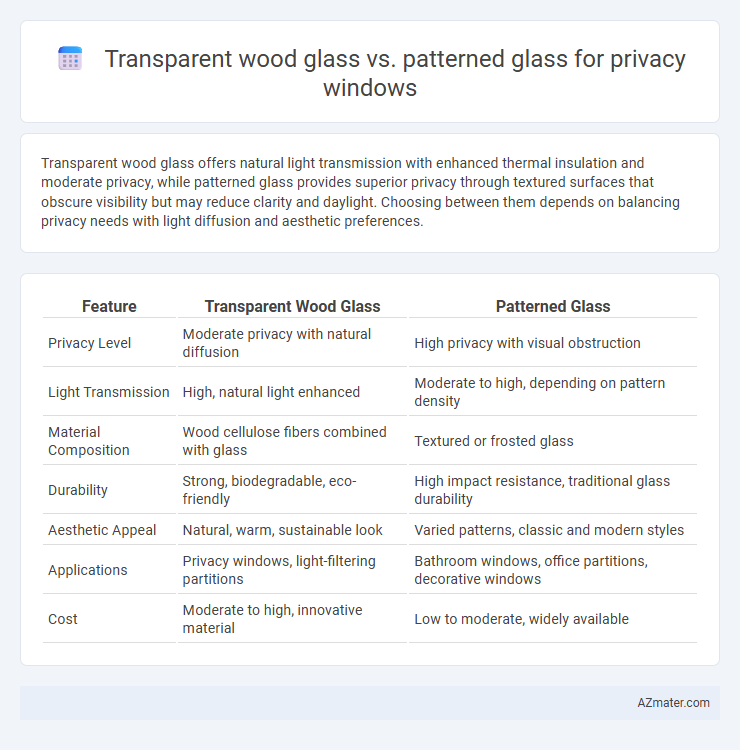Transparent wood glass offers natural light transmission with enhanced thermal insulation and moderate privacy, while patterned glass provides superior privacy through textured surfaces that obscure visibility but may reduce clarity and daylight. Choosing between them depends on balancing privacy needs with light diffusion and aesthetic preferences.
Table of Comparison
| Feature | Transparent Wood Glass | Patterned Glass |
|---|---|---|
| Privacy Level | Moderate privacy with natural diffusion | High privacy with visual obstruction |
| Light Transmission | High, natural light enhanced | Moderate to high, depending on pattern density |
| Material Composition | Wood cellulose fibers combined with glass | Textured or frosted glass |
| Durability | Strong, biodegradable, eco-friendly | High impact resistance, traditional glass durability |
| Aesthetic Appeal | Natural, warm, sustainable look | Varied patterns, classic and modern styles |
| Applications | Privacy windows, light-filtering partitions | Bathroom windows, office partitions, decorative windows |
| Cost | Moderate to high, innovative material | Low to moderate, widely available |
Introduction to Privacy Window Solutions
Transparent wood glass combines natural aesthetics with moderate privacy by diffusing light while maintaining visibility, making it ideal for spaces seeking a balance between openness and seclusion. Patterned glass enhances privacy through textured designs that obscure clear views, offering versatile options for both residential and commercial applications. Both materials optimize light transmission while ensuring privacy, catering to diverse architectural needs and interior styles.
What is Transparent Wood Glass?
Transparent wood glass is an innovative material combining natural wood fibers with transparent polymers to create a strong, lightweight panel that offers both privacy and light transmission. Unlike patterned glass, which obscures visibility through surface textures, transparent wood glass diffuses light softly while maintaining a degree of translucency that enhances privacy without sacrificing natural illumination. Its sustainable properties and thermal insulation benefits make it a cutting-edge choice for privacy windows in modern architectural designs.
What is Patterned Glass?
Patterned glass features textured surfaces that obscure visibility while allowing natural light to pass through, enhancing privacy in windows. It is created by pressing patterns into molten glass or using rolled glass techniques, resulting in diverse designs like frosted, ribbed, or floral patterns. Compared to transparent wood glass, patterned glass provides effective privacy without compromising light transmission, making it ideal for bathroom and office windows.
Privacy Performance: Transparent Wood Glass vs Patterned Glass
Transparent wood glass offers moderate privacy by diffusing light while maintaining some visibility, making it suitable for spaces that require subdued transparency. Patterned glass provides higher privacy performance due to its intricate surface designs that obscure direct views without compromising natural light. For privacy windows, patterned glass typically outperforms transparent wood glass by delivering superior visual obstruction and enhanced privacy protection.
Light Transmission and Ambiance Comparison
Transparent wood glass offers higher light transmission than patterned glass, allowing natural daylight to brighten interiors while maintaining moderate privacy through its unique fibrous texture. Patterned glass diffuses light more effectively, creating a softer ambiance with enhanced privacy by obscuring clear views but often resulting in reduced brightness. The choice depends on prioritizing either maximum light flow with subtle privacy or stronger concealment paired with a mellow, filtered lighting effect.
Energy Efficiency and Insulation Properties
Transparent wood glass offers superior insulation properties compared to patterned glass due to its composite structure of wood fibers and polymers, which enhances thermal resistance and reduces heat transfer. Patterned glass provides moderate privacy but typically has lower energy efficiency since its single-pane design lacks the insulating benefits found in transparent wood glass. Transparent wood glass can lower heating and cooling costs by maintaining consistent indoor temperatures, making it a more energy-efficient choice for privacy windows.
Durability and Maintenance Factors
Transparent wood glass offers superior durability with its composite structure combining wood fibers and resin, making it highly resistant to impact and weathering, unlike patterned glass which is more prone to chipping and surface scratches. Maintenance of transparent wood glass is simpler due to its smooth, non-porous surface that resists dirt accumulation and requires only occasional cleaning with mild soap and water; patterned glass often demands more frequent cleaning to maintain clarity and can show smudges easily due to etched or textured surfaces. Both materials provide privacy, but transparent wood glass balances aesthetics with long-term durability and low upkeep, ideal for privacy windows exposed to harsh environmental conditions.
Aesthetic Versatility and Design Options
Transparent wood glass offers unique aesthetic versatility by combining natural wood textures with clear visibility, creating a warm, organic ambiance suitable for modern and rustic interiors. Patterned glass provides diverse design options through varied textures and motifs that obscure views while allowing light transmission, making it ideal for enhancing privacy without sacrificing style. Both materials enable customizable applications, but transparent wood glass stands out for its blend of natural elements and contemporary transparency, enhancing interior design with a tactile and visual appeal.
Cost Analysis: Transparent Wood Glass vs Patterned Glass
Transparent wood glass typically incurs higher upfront costs due to advanced manufacturing processes and sustainable sourcing of materials, whereas patterned glass is generally more affordable and widely available, making it a budget-friendly option. Maintenance expenses for both remain relatively low, but transparent wood glass may offer longer durability and energy efficiency benefits, potentially offsetting initial investment over time. Cost analysis should also consider installation complexities, as patterned glass often requires simpler fitting, reducing labor expenses compared to the customized handling needed for transparent wood glass.
Choosing the Best Privacy Glass for Your Needs
Transparent wood glass combines natural aesthetics with moderate privacy by diffusing light while maintaining visibility, ideal for spaces requiring privacy without sacrificing daylight. Patterned glass offers enhanced obscurity through textured designs that distort images and block clear views, making it suitable for bathrooms or confidential areas. Choosing the best privacy glass depends on balancing privacy level, light transmission, and design preference to meet specific functional and aesthetic needs.

Infographic: Transparent wood glass vs Patterned glass for Privacy window
 azmater.com
azmater.com